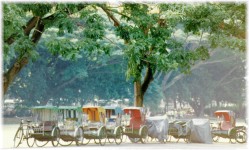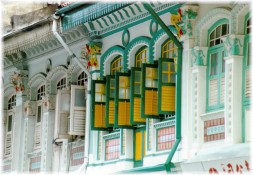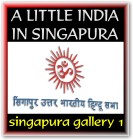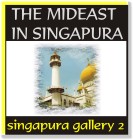There is more to the intrigue of durian though. Durian is something
akin to garlic only more so. Many people like garlic, but are afraid that
the lingering scent of it on their breath may offend others. Try to imagine
a fruit in a country with an enormous variety of delicious fruit that is
prized far above the others and yet has an equally important smell that
accompanies it. Durian smells rotten. I tried to ask someone why everyone
who purchases the fruit always places it up to their nose before doing
so. You can smell the fruit from ten or more feet away! I didn't get an
answer to my question, just an agreement that it smelled and that it had
a taste from heaven. The proprietors of a hotel we stayed at felt it necessary
to wage combat with this popular fruit by permanently affixing a sign in
the simple international language of a pictogram. It was a picture of several
durian with a large red "X" over them so that no one would bring one to
their room.
What does durian taste like to the uninitiated? I had to try it. It's
difficult getting past the smell, but the fact that the fruit's odor often
permeated the air in the streets which I walked helped. The flavor does
not grab you at first the way an Indian mango will, but there was something
unique and wonderful about its flavor. Another few pieces and I might have
been durian's next victim.
 |
 |
At the outset, I explained that my interest in Malaysia did not grow from the Chinese population there that wields tremendous economic power, but rather from the Malay population.
I had little interest in exploring Chinese culture in the peninsula and Singapore was, but an afterthought. My bias as such led me to be
dismissive of Singapore where most others would view Singapore as the most important city I to cover here. You cannot be dismissive
of Singapore however. It is an important city historically and economically. It is amazing when, in the midst of the 20th Century megapolis, to think that Singapore was nearly barren
less than two centuries ago. Also of interest to me were the similarities and contrasts of this island, nation-state with another former
island, nation-state having a similar history, Hong Kong.
The existence of Singapore, Malaysia, Brunei, Indonesia and even the Philippines as different states is precarious and it is
just as likely that boundaries dependent of shared cultural values rather than colonial experience may reshape the region in the next century.
Western powers vied for control of key areas in the region to exploit the resources found there through the mercantile system.
The presence of the colonial powers: Spain, Portugal, Holland, and Great Britain rested on trade from the area. Spain had a trade route linking China, Manila, and Mexico.
The Portuguese were the first European power to exploit the port of Malacca. The Dutch took control of this port before shifting
their focus to what is now Jakarta on the island of Java. The British opened the first port of what would become the Straits Settlements
of Peninsular Malaysia at Penang in 1786. Sir Stamford Raffles enthusiastically took over the colonial administration of control of Dutch possesions on Java during the Napoleonic
Wars on behalf of the British. After Napoleon's final defeat the Dutch resumed control of Java and the important port at Batavia (modern Jakarta), eventually
relinquishing control of Malacca to the British, and Sir Stamford Raffles negotiated for the rights to land on the island of Singapura
to establish a new trading post. This trading post's success soon eclipsed that of the other colonial ports of Southeast Asia including the
Straits Settlements at Penang and Malacca. The population of Singapura was infintesimal until the trading post was established, and its growth is now
legendary. The predominance of ethnic Chinese on the island is a direct result of the laissez-faire trade administration of the British. Not surprisingly,
modern Singapore bears a striking similarity to Hong Kong, another important "trading post" established by the British in the 19th Century.
 In the initial time period known as the "Post-Mao" years in China when that country began to open up to the rest of the
world, a debate developed over who was more Chinese. Those who stayed in China during the height of communism and the Cultural
Revolution or those who fervently held on to traditional Chinese culture in distant lands such as Nanyang (Southeast Asia).
Some argued that those who left China were more committed to traditional Chinese culture if for no other reason than their longing for the homeland
necessitated it. Which of the former English colonial islands was more Chinese, Hong Kong or Singapore? Politically at least, Singapore under Lee
Kwan Yew was more Chinese than British administered Hong Kong. Lee Kwan Yew, a British trained technocrat was surprisingly Confucian in the way that he
ruled.
In the initial time period known as the "Post-Mao" years in China when that country began to open up to the rest of the
world, a debate developed over who was more Chinese. Those who stayed in China during the height of communism and the Cultural
Revolution or those who fervently held on to traditional Chinese culture in distant lands such as Nanyang (Southeast Asia).
Some argued that those who left China were more committed to traditional Chinese culture if for no other reason than their longing for the homeland
necessitated it. Which of the former English colonial islands was more Chinese, Hong Kong or Singapore? Politically at least, Singapore under Lee
Kwan Yew was more Chinese than British administered Hong Kong. Lee Kwan Yew, a British trained technocrat was surprisingly Confucian in the way that he
ruled.
Both Singapore and Hong Kong have predominately
Chinese populations with a smaller population of people from another British colonial possessian, India. As the Chinese population on these two islands
grew increasingly affluent, they began to employ sizable numbers of Filipinos for domestic services. There are also sizeable populations of European and American
expatriates. The most modern areas of both cities are studded with
worldclass shopping centers and fine eateries. The much more restrained city of Singapore is cleaner and duller than its counterpart. Hong Kong has the uncontrollable flotsam and jetsam of a densely crowded Chinese city or one of the world's
Chinatowns. Singapore's Arab section and Little India are very interesting, culturally
distinct districts the likes of which cannot be found in this regard in
Hong Kong. Hong Kong Island's skyline is world class, Singapore's is wholly
unspectacular. There is something in the dress of Singaporeans that is
far better than that of their counterparts in Hong Kong. Even the way the
Singapore women who choose to dress risqué do so better than their
distant cousins in Hong Kong. Singaporeans are more civil and less rude
than the masters of offense in Hong Kong, but this cannot be attributed
entirely to restrictions on special behaviors put in place by the once
supreme Mandarin, Lee Kuan Yew. Which is better? They're both large areas
with the vast majority of the people crammed into small areas where industry,
retail and other businesses are also centered. Sure these two cities are
much more complex than this, but to a vicarious visitor, much of the rest is extraneous
detail more accessible and enjoyable in other areas.

| MORE VIEWS OF SINGAPORE: |
 |
 |

